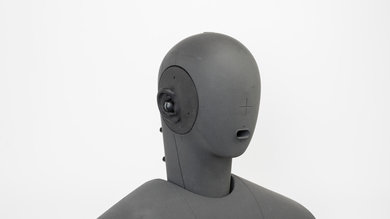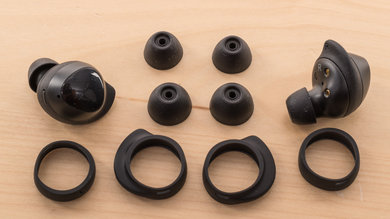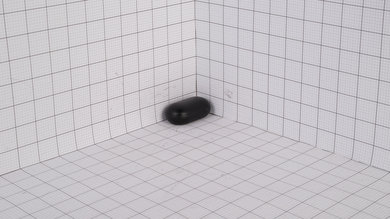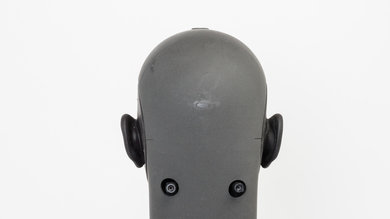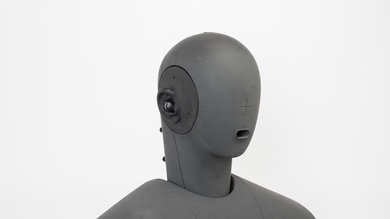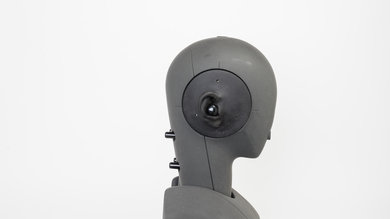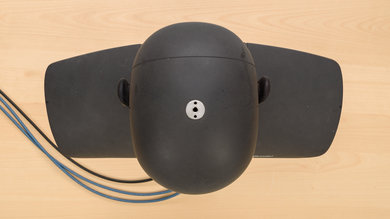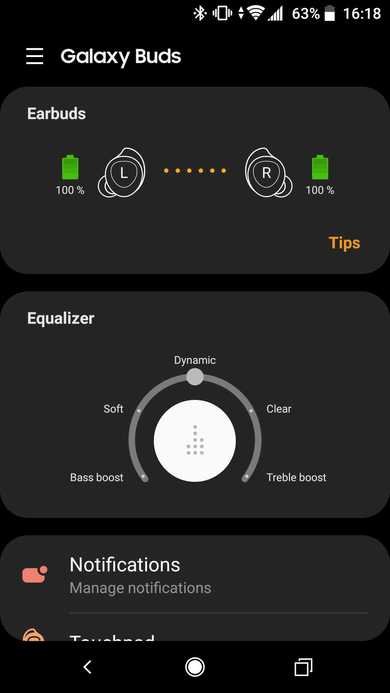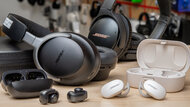Update: 02/24/2020: Our original unit of the Samsung Galaxy Buds unfortunately broke, so we ordered and re-tested a replacement unit. There are a few differences in sound and isolation, but we cannot confirm whether they're due to actual changes in the new unit's performance, or simply a result of slight variations in the fit and seal when re-testing. Note however that while our unit gave us significant connection issues and audio cuts while testing, we had no such problems with our new unit on the latest firmware.
The Samsung Galaxy Buds are well-rounded, truly wireless headphones. They're comfortable, feel well-built, and are very portable. Their balanced, neutral sound profile makes them suitable for a wide variety of music genres, and their battery lasts a fair while too. They isolate a decent amount of ambient noise, and they barely leak, making them suitable for use at the office and while commuting. Unfortunately, their default control scheme is limited and can't be changed if you don't have an Android device. On the upside, they have remarkably low latency when watching YouTube videos on both iOS and Android.
Our Verdict
The Samsung Galaxy Buds are decent for mixed usage. They have a versatile sound profile that lends itself well to all different kinds of music. Their in-ear design isolates a decent amount of ambient noise, which is good for commuting and use at the office. The buds are small and fit securely too, which makes them great for sports. While they have very low latency while watching YouTube videos on a smartphone, they aren't suitable for gaming.
- Decent audio reproduction.
- Comfortable and durable design.
- Long single charge battery life for truly wireless headphones.
- Very high latency.
- Connection stability issues.
- In-ear fit might not be comfortable for everyone.
The Samsung Galaxy Buds are very good for neutral listening thanks to their remarkably well-balanced sound profile. Bass is deep and punchy without overpowering vocals, and instruments while treble is clear and bright without sounding harsh or sharp. You should be able to enjoy a wide range of music genres with these earbuds.
Good for commuting. While they don’t do a great job against low-frequency noises like engine rumbles, they are very comfortable and easy to carry around. Their battery life is also suitable for longer rides and flights, which is nice for truly wireless headphones.
Great for sports. Their small bud design fits nicely into the ears and shouldn’t pop out during physical activities. They don’t trap heat inside the ears so you shouldn’t sweat more than usual when wearing them, which is great. However, they might have a similar clogging problem to the Samsung Gear IconX, which we will monitor as we continue to use them. However, they don't have internal storage like the previous model, which was useful for those wanting to work out without having your phone on you.
Decent for the office. The Samsung Galaxy Buds do a good job at isolating against ambient chatter and high-frequency noises like A/C systems. They are also comfortable, but the in-ear fit might not be the most ideal for a long workday. On the upside, they barely leak, so you’ll be able to mask more ambient noise by raising your volume without disturbing surrounding colleagues. However, while their battery life is longer than most truly wireless headphones we’ve reviewed so far, it might still not be enough for a full workday and might need daily charging, especially if you plan on using them during your commute to work.
Poor for gaming. Their latency is way too high for gaming and if you’re playing online games, their microphone is mediocre. They won’t be as customizable as gaming headphones we’ve reviewed so far, and we don’t consider the in-ear fit to be very comfortable for long gaming sessions.
Changelog
- Updated Feb 21, 2020: Converted to Test Bench 1.4.
- Updated Nov 21, 2019: Converted to Test Bench 1.3.1.
- Updated Nov 21, 2019: Converted to Test Bench 1.3.
- Updated Apr 26, 2019: We've updated the controls score to reflect the latest update.
Check Price
Popular Headphones Comparisons
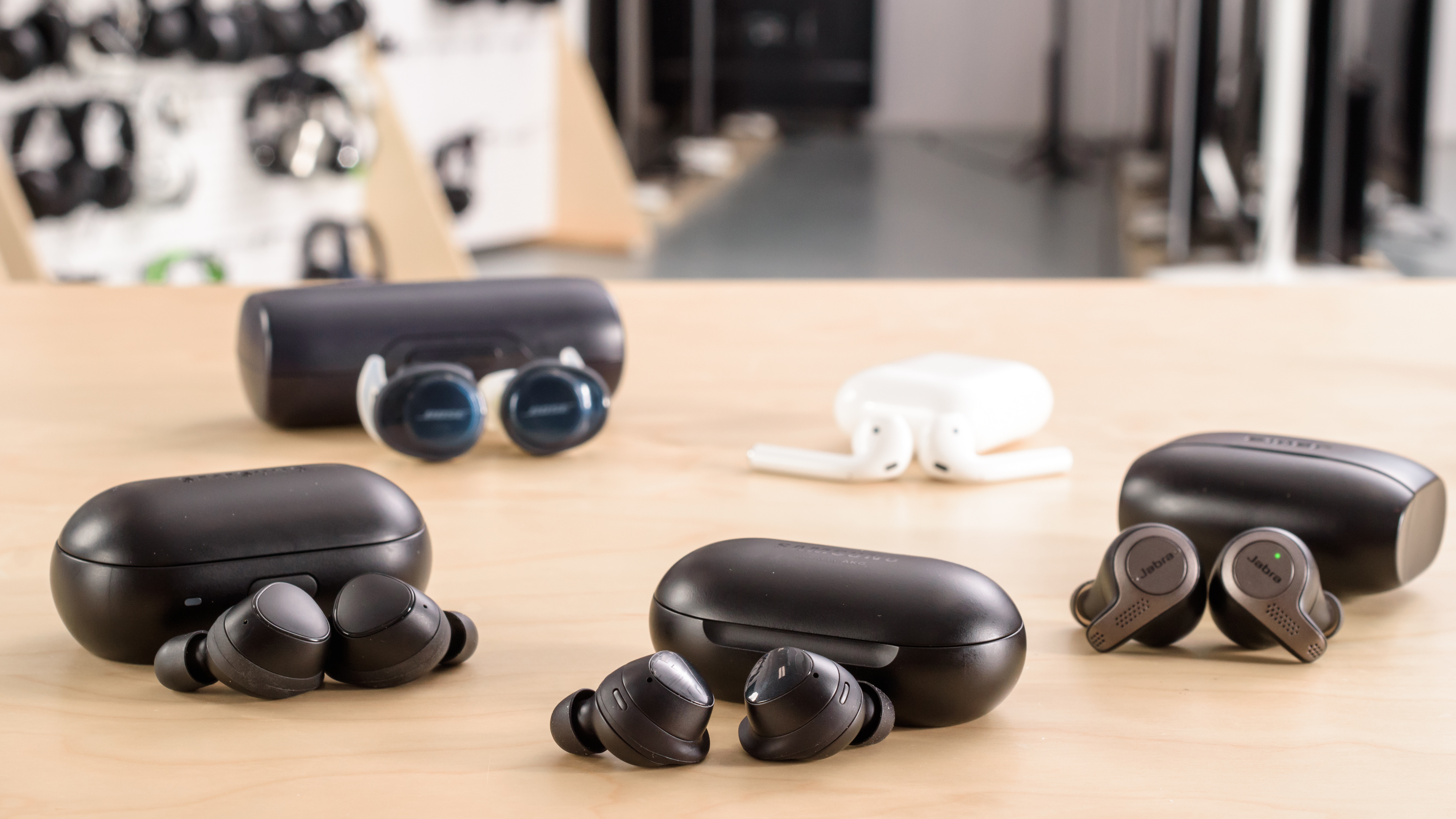
The Samsung Galaxy Buds are decent truly wireless headphones that set themselves apart thanks to their wireless Qi charging case and their versatility for everyday casual use. However, they have very high latency, and we had a few connection stability issues with our unit. We suggest taking a look at our recommendations for the best truly wireless earbuds, the best wireless earbuds, and the best noise cancelling earbuds and in-ears.
The Samsung Galaxy Buds+ are a decent improvement over the previous generation Samsung Galaxy Buds. Both truly wireless headphones are very small, lightweight, and comfortable, and they look identical. They both have an extremely well-balanced sound profile out of the box, and access to five different EQ presets. The Buds+ have a much longer 13.5-hour battery life, which is quite impressive for a pair of truly wireless headphones, and you still get an additional full charge from the case. iPhone users can also access the customization options now, as Samsung has made a version of the companion app available for iOS devices, which is great.
The Samsung Galaxy Buds and the Samsung Gear IconX Truly Wireless are very similar headphones. They perform almost the same way and have practically the same audio reproduction. The Gear IconX have 4GB internal storage, which is very useful to load music on them and work out without your phone. On the other hand, the newer Galaxy Buds now support wireless Qi charging and have a noticeably better microphone. They also have a longer battery life, but latency is worse on the Galaxy Buds than the Gear IconX.
The Samsung Galaxy Buds are much better truly wireless in-ears than the Razer Hammerhead True Wireless 2019. The Samsung are comfier, feel better built, have a much better-balanced sound profile, block more background noise, and have a dedicated companion app with a broader range of sound customization features. On the other hand, the Razer have lower latency with gaming mode enabled.
The Samsung Galaxy Buds are slightly better headphones than the Samsung Galaxy Buds Pro. While both are well-built and comfortable, the original Buds are more stable and have a more neutral default sound profile, which some users may prefer, and their battery performance is better. However, the Pro can block out more background noise, thanks to their ANC system.
Test Results

The Samsung Galaxy Buds are very small and don't protrude much out of your ears. The bud design is sleek and feels high-end, and the back of the headphones are glossy and act as a touch-sensitive control scheme. They come in three monochromatic designs: black, white, and yellow.
The Galaxy Buds are very comfortable in-ears. They don't enter your ear canal too deeply and don't put pressure on your inner ear. They are very lightweight, and you barely feel them. The stability sleeves help get a nice fit, but not everyone will find in-ears as comfortable, and some might suffer from soreness after a while. On the upside, they come with three options for both tips and fin sleeves to help you find the best possible fit.
Update: 04/26/2019: A new firmware update for the Galaxy Buds now lets you toggle Ambient Mode with a long press. It also makes double and triple taps easier to use and now has an implementation for Bixby voice-enabled commands.
These earbuds have a decently easy-to-use, touch-sensitive surface on the back of the earbuds. You get access to common functionalities such as call and music management and track skipping. You can also map the press and hold command inside the mobile app, which is not available on iOS. You can choose between volume control, voice-enabled controls, or ambient noise mode. However, mapping the volume controls automatically sets the right earbud to volume up and the left one to volume down. On the upside, if you prefer to change your listening volume on your device, you can set the voice-enabled controls and the ambient noise mode on separate buds. However, without the app, the default setup is the device's voice assistant.
The Galaxy Buds' case is solid and compact enough to carry around on you at all times. It protects the headphones from physical damage from falls and scratches. However, since it's a charging case, you shouldn't expose it to water. Unfortunately, the case only holds about one additional charge, which is slightly disappointing when compared to other similar truly wireless earbuds. On the upside, the case supports wireless Qi charging.
These earbuds are well-built and feel solid, but aren't quite on par with the nice and dense build of the Sennheiser Momentum True Wireless or the unique design of the Apple AirPods (2nd generation). Nevertheless, the Galaxy Buds should survive a few accidental drops without too much damage, and their case protects them well. We will keep using the headphones and see if the Galaxy Buds have the same clogging problem as the similarly designed Samsung Gear IconX when working out with them, especially since they are also rated IPX2, which is slightly disappointing.
The Galaxy Buds are stable headphones, and you should be able to jog with these without them popping out. Their stability fins aren't as big as the Samsung Gear IconX, but they feel as secure, and you should still be able to be active with them. They stay in place during workout routines, and their wireless design gets rid of a cable that could yank the headphones out of your ears. Also, they come with different tip and fin sizes, so you should be able to mix and match to find the most secure and comfortable fit for you.
They have an excellent frequency response consistency. If the user is able to achieve a proper fit and an airtight seal using the assortment of tips that come with the headphones, then they should get consistent bass and treble delivery every time they use the headphones.
The Samsung Galaxy Buds have a very good bass. LFE (low-frequency extension) is at 27Hz, which is good, but combined with low-bass of -3 dB, indicates that the earbuds are a bit light on sub-bass. Mid-bass, where the body of bass guitars and the punch of kick drums sit, is quite well-balanced but underemphasized by 2.5 dB. High-bass, however, is flat but there is a slight bump before 250Hz, which adds a bit of boominess to the sound.
The mid-range performance of the Galaxy Buds is flat and even, but it's slightly overemphasized. Vocals and lead instruments will be accurately reproduced, but they might sound a bit forward in the mix, with high projection and intensity. The 2 dB bump in low-mid might also make vocals and leads a bit thick and cluttered.
The treble of the Galaxy Buds is great. The response throughout the range is very well-balanced, but slightly over our target curve. This results in sibilants (S and T sounds) to feel overly bright and piercing, especially around 10KHz. However, not everyone will hear them as sibilant.
The imaging is excellent. Their weighted group delay is 0.13, which is very low. The GD graph also shows that the entire group delay response is below the audibility threshold, suggesting a tight bass and a transparent treble reproduction. Additionally, the L/R drivers of our test unit were exceptionally matched, which is important for the accurate placement and localization of objects and instruments (like voices and footsteps) in the stereo image. However, these results are only valid for our unit, and yours may perform differently.
Like most other in-ears, the soundstage of the Samsung Galaxy Buds is poor. This is because in-ears bypass the pinna (outer ear) and don't interact with it. Activating the resonances of the pinna is one of the key factors in creating a speaker-like and out-of-head soundstage. Also, because of their closed-back design, their soundstage tends to be less open than that of open-back headphones.
The Samsung Galaxy Buds have an okay isolation performance. In the bass range, occupied by the rumble of airplane and bus engines, they reduce the noise by about 4 dB, which won't be as good as noise cancelling headphones. In the mid-range, important for blocking speech, they get 21 dB of isolation, which is very good. In the treble range, occupied by sharp S and T sounds and A/C system noise, they achieved more than 44 dB of isolation, which is excellent. For truly wireless in-ears with better passive noise isolation, take a look at the Cambridge Audio Melomania 1 or the JBL Reflect Flow.
The leakage performance is excellent. These in-ears do not leak in the bass and mid-ranges, and the entire leakage is concentrated in a narrow band in the treble range, meaning it will consist of sharp sounds like S and Ts. The overall level of the leakage is not very loud, either. With the music at 100 dB SPL, the leakage at 1 foot away will average around 25 dB SPL but peaks at 47 dB SPL, which is just under the noise floor of most offices.
The recording quality of the Galaxy Buds' microphone is okay. LFE (low-frequency extension) is at 302Hz, which is sub-par. This results in a recorded/transmitted speech that's relatively thin-sounding. The HFE (high-frequency extension) of 3.4KHz means that speech will sound noticeably muffled and lacking in detail. This HFE performance is a limitation of the Bluetooth protocol and is a common shortcoming between almost all Bluetooth headphones. However, it will still be relatively easy to comprehend, since speech intelligibility is mostly dependent on the 500Hz-4KHz range.
The microphone is mediocre at noise handling. In our SpNR test, the mic achieved a speech-to-noise ratio of 11 dB, indicating that it is best suited for quiet environments. However, in moderate and loud environments, the mic will have difficulty fully separating speech from ambient noise.
The Galaxy Buds advertised six hours of continuous playback, but we measured more than seven hours, which is great. This is one of the longest-lasting battery lives on a single charge for truly wireless headphones we've tested so far. Unfortunately, their case only holds about one additional charge, which is noticeably less than most similar headphones, but at 14 total hours, it should be long enough for most users. On the upside, they last about 20 hours in their standby mode according to Samsung's specs sheet, and you can also use one bud while the other one is charging in the case, which is convenient. If you're often on the move and need something that offers additional charges, check out the Amazon Echo Buds (1st generation). You may also want to check out the upgraded Samsung Galaxy Buds Plus, which have a much longer single-charge battery life.
The Galaxy Buds are compatible with the Samsung Wearable app, which offers a few information details and equalizer presets. You can map the touch-sensitive buttons of the earbuds inside the app to volume controls, voice commands, or ambient noise mode. You also have access to the battery data, and you can enable a read-notification function. You can also make your earbuds beep loudly if you've lost them and are looking for them. The Galaxy Buds Manager is also available on macOS and Windows, but we would always get an error message when trying to run the app.
These are Bluetooth-only headphones and support version 5.0. However, they can only be connected to one device at a time and don't support NFC. Also, the connection stability of our unit was finicky, and we would get some drops in audio, even after installing the latest firmware update (which stated this issue was fixed in the patch notes).
Their latency is very high, and you will notice a delay when watching video content or gaming. Some apps and devices seem to offer some sort of compensation, but the delay will most likely still be very noticeable.
The Galaxy Buds' hard charging case offers an extra 6 to 7 hours of playback time, according to the specs sheet, but it doesn't have any audio outputs, like most truly wireless cases. On the upside, it also supports wireless Qi charging.

